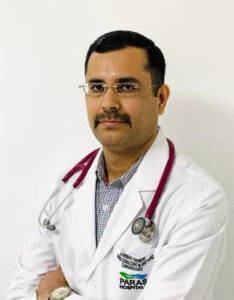Best Doctors in India for Thrombolysis Treatment
- Interventional Cardiologist, Gurugram, India
- Over 10 years’ experience
Profile Highlights:
- Dr. Jagdeep Yadav is one of the best cardiac surgeons in Gurugram. He is particularly interested in non-coronary therapies such as peripheral interventions and device closures.
- Dr. Jagdeep Yadav is skilled in using modern techniques in interventional cardiology and non-invasive cardiology procedures. He employs cutting-edge technologies such as IVUS, OCT, FFR, and IVL to make life better in complex cardiac therapies.
- Cardiologist, Gurugram, India
- Over 15 years’ experience
Profile Highlights:
- Dr. Sanjat Chiwane is an MCI Certified young cardiologist in Gurugram.
- His career success measured 1200+ coronary angioplasties, 100 Balloon mitral valvuloplasties, and 100 renal angioplasties.
- Continuing with his meticulous career, the doctor also worked as a Clinical Instructor in Medicine and Cardiology at Mumbai University. He added Organ Transplantation to his expertise.
- Cardiologist, Gurugram, India
- Over 16 years’ experience
Profile Highlights:
- Dr. Kuldeep Arora is a promising cardiologist in Gurugram. He is a specialist in radial angiography and angioplasty.
- Dr. Kuldeep Arora has expertise in Interventional Cardiology and performed around 12,000 therapeutic cardiac interventions.
- He also assisted with the device closure of atrial septal abnormalities, Pacemaker implantations, ICD, and CRT, besides management of heart attacks.
- Cardiovascular Surgeon, Cardiac Surgeon, Gurugram, India
- Over 32 years’ experience
Profile Highlights:
- Dr. Vijay Kohli is one of the best cardiac surgeons in India. He has brought an evolution in the spectra of Cardiac Surgery, wherein, he was the first leading surgeon to perform CABG on a beating heart in Kathmandu, Nepal.
- Vijay Kohli performed the first coronary artery bypass surgery in Jammu Medical College in 2001.
- Additional Director Cardiology
- 15 Years Experience
Profile Highlights:
Profile Snapshot of Dr. Hemant Gandhi
- Hemant Gandhi is a distinguished figure in the field of interventional cardiology with over 15+ years of extensive experience.
- He is recognized for his proficiency in handling cases involving congenital heart defects such as ASD and PDA, along with peripheral angiography, angioplasty, and balloon valvuloplasty.
- Gandhi holds the distinction of being the first D.M. (Cardiology) candidate to graduate from the prestigious PGIMER and Dr. RML Hospital, New Delhi.
- Beyond his clinical practice, he is actively engaged in the education and training of medical students in the specialized domain of Cardiology.
- His contributions to academia are further underscored by a significant number of publications that enrich the field with his insights and research findings.
Best Hospitals in India for Thrombolysis Treatment
Thrombolysis
Thrombolytic therapy commonly known as thrombolysis, is a treatment for dissolving dangerous clots in the blood vessels and for improving blood flow. It can also prevent damage to your tissues and organs.
This procedure is often used as an emergency treatment for dissolving blood clots that form in arteries that feed the heart and brain, which leads to heart attacks and ischemic strokes.
Purpose
When blood clots form in a blood vessel, it severely reduces or even cuts off blood flow to the parts of your body that are served by that blood vessel. This event can lead to serious damage to those particular parts of the body. If the clot forms in an artery supplying blood to your heart, for example, it can lead you to a heart attack. Similarly, a clot cutting off blood to your brain might lead to a stroke.
Thrombolysis is a treatment meant for dissolving blood clots which can cause serious and even life-threatening damage unless they are eliminated from the system. According to research, when this treatment is used for treating stroke, thrombolysis can help to prevent or reverse paralysis as well as any such problems that might result otherwise.
In the case of a heart attack, thrombolysis is an alternative to stenting, a procedure which involves inserting a spring-like device into a blocked blood vessel. Stenting is generally the preferred treatment, as it both removes the clot as well as opens the blood vessel, which may have internal cholesterol deposits. Though thrombolysis removes only the clot, it has an advantage and it is that it can be administered in hospitals with fewer resources.
Thrombolysis is also used for dissolving blood clots forming in catheters or tubes put into people’s bodies for medical treatments, such as dialysis or chemotherapy.
Preparation
Thrombolysis is usually an emergency treatment; therefore, you may not always have time to prepare for it. If you are diagnosed with a condition that is treatable with thrombolysis, you will be transferred to an intensive care unit so that your heart and lung functions can be closely monitored.
If you will be undergoing catheter-directed thrombolysis, you might be asked to fast.
Procedure
Clot-busting agents are generally given in two ways: through a peripheral IV or through a thin tube termed as a catheter, which is navigated to the site of the clot.
First, the clot-busting drug will be administered. This is usually performed in an ICU while your healthcare team monitors your heart and lung functions. The drug circulates within your bloodstream until it reaches the clot. In most cases, the blood clot should dissolve within a day or two. The procedure is monitored closely by your healthcare team using special X-rays and ultrasound scans. These images can also help to determine if the vein wall is damaged or narrowed, making it prone to more clots in the future.
After the procedure
In most cases, the treatment should reverse or alleviate the symptoms. However, the treatment is not always a success, and it might not dissolve the blood clot. This might be the case if the initiation of the treatment was delayed. At other times, even if the clot has dissolved, the affected tissues can get damaged permanently, due to a prolonged restriction of the blood flow. In such cases, further treatment can be required for addressing the causes of the blood clot, as well as repairing any damaged tissues and organs.
Risks
Although thrombolysis can usually improve blood flow safely and effectively as well as relieve or eliminate any symptoms in most patients without the need for any more invasive surgery, it cannot be recommended for every person. It is not suitable for patients who regularly use blood-thinning medication, herbs or dietary supplements or for people with certain conditions associated with an increased risk of bleeding. Some of these conditions include:
- Severe high blood pressure
- Hemorrhagic stroke resulting from bleeding in the brain
- Active bleeding or severe blood loss
- Severe kidney disease
- Recent surgery
Patients who undergo this procedure have a very small risk of infection as well as a slight risk of an allergic reaction to the contrast dye which can be required for imaging.
Besides the risk of serious internal bleeding, there are few other risks, which include:
- Bruising or bleeding at the access site
- Migration of the blood clot to another part of the vascular system
- Damage to your blood vessel
- Kidney damage in patients having diabetes or other pre-existing kidney diseases
Intracranial bleeding is the most serious complication which is possible and it is potentially fatal. However, this complication is generally very rare.







